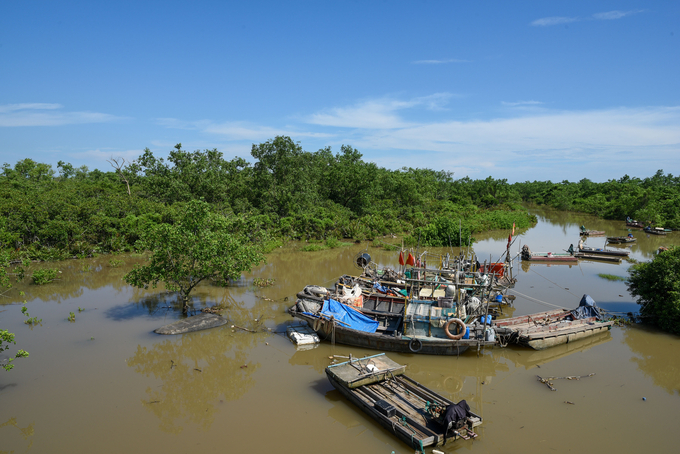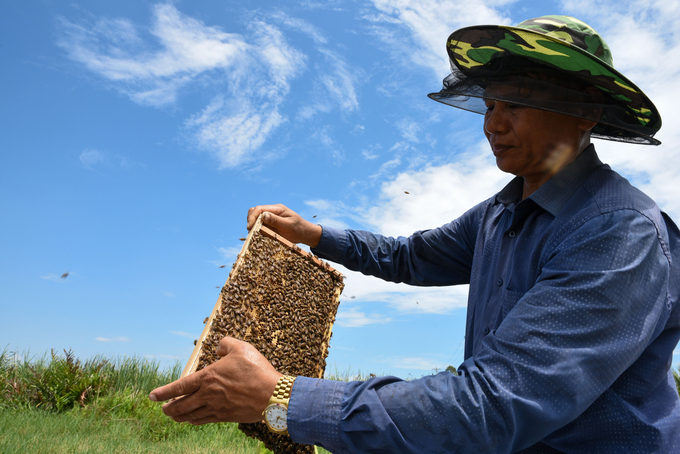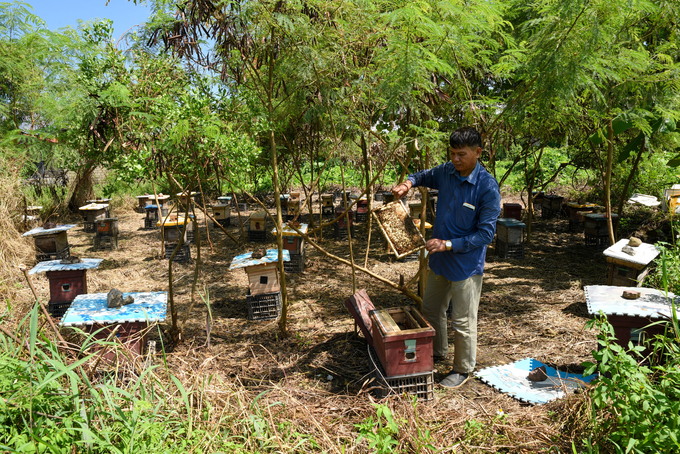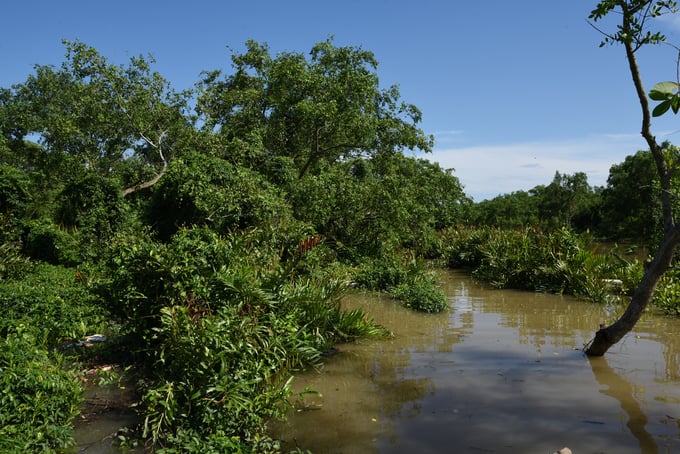May 31, 2025 | 20:11 GMT +7
May 31, 2025 | 20:11 GMT +7
Hotline: 0913.378.918
May 31, 2025 | 20:11 GMT +7
Hotline: 0913.378.918

A corner of the Dai Hop mangrove forest. Photo: Duong Dinh Tuong.
Despite having ventured into forests, sailed the seas, and traveled through many lowland regions, tasting various types of honey, rarely had I encountered one with such a refreshing sweetness and delicate fragrance. That’s why I made a mental note to visit Hai Phong someday to learn more about this honey.
It wasn’t until three years later that I finally had the chance to meet Mr. Dang Thanh Tung, Director of Tung Hang Honey Production Cooperative (Dai Hop Commune, Kien Thuy District, Hai Phong City). As he handed me a cup of golden honey, I took a sip. It still had that refreshing sweetness and gentle aroma, awakening both my taste and smell senses.
"Why is it that many places have honey from mangrove forests, but the honey in Dai Hop Commune has such a unique taste and aroma?" I asked curiously. Mr. Tung smiled and explained that there are several reasons:
First, the mangrove forest has three main types of flowers: Su, Ban and Vet. Among them, the nectar from Ban flowers is of the highest quality, with the largest quantity, blooms from March to June and from August to December. Su flowers produce decent-quality nectar, blooming from February to April, while Vet flowers offer the lowest-quality nectar, blooming from May to June. Depending on the dominant tree species in the mangrove forest, different qualities of honey are produced. Fortunately, in Dai Hop, Ban trees make up about 70-80% of the forest, with some ancient trees towering over 10 meters tall.
Second, while most places leave honey as it is after extraction without reducing the moisture content, which leads to quicker degradation, the Tung Hang Honey Production Cooperative uses technology to reduce the water content to below 21%, in line with international standards. The last and most important reason is that the cooperative uses native bees instead of Italian bees. It's like comparing native chickens to industrially farmed ones - the quality is entirely different, even though the yield is lower.

Mr. Dang Thanh Tung, Director of Tung Hang Honey Production Cooperative, inspecting the bee colonies. Photo: Duong Dinh Tuong.
That day, the weather alternated between rain and sunshine, giving me the rare opportunity to wander around the Dai Hop mangrove forest with Tung. Normally, he's too busy to spend more than an hour with anyone. The salty sea breeze filled the air. The waves, red with silt, became gentle as they reached the shore, protected by the mangrove forest. Honeybees have natural enemies like hornets, wasps, dragonflies, geckos and frogs. To deal with predatory bees, Tung uses nets for protection, while dragonflies, frogs and geckos are caught manually.
During his time in the army, stationed in Quang Ninh and Lang Son, Mr. Tung often ventured into the forests to gather vegetables and catch bees to raise for honey. After his military service, he returned home to work in the fishing industry and eventually became the head of the supervisory board of Dai Hop Agricultural Cooperative, thinking that his beekeeping days were behind him.
In 1997, Japan funded a mangrove forest planting project in Hai Phong to reduce disaster risks along the Van Uc River estuary. The project extended from Dai Hop Commune in Kien Thuy District to Bang La Ward in Do Son Town, covering about 650 hectares. By the year 2000, the forest started to bloom and beekeepers from Hai Duong brought their hives to the area.
Mr. Tung observed that beekeeping was a new livelihood opportunity for his community, so he bought two hives for 25 USD, despite many people calling him foolish, as that amount could buy honey for years. He chose native bees instead of Italian bees because they are easier to manage, require less movement and produce quality honey, even though their yield is only about one-third to one-quarter of Italian bees. However, the selling price is two to three times higher.
From the two hives he purchased at the beginning of the year, by the end of the year, he had expanded to seven hives, collecting 30 liters of honey, which he sold at 2 USD per liter.
Seeing a bright path ahead, he promoted beekeeping to many villagers, especially those in poor health or beyond working age. Initially, only three households (Nguyen Minh Tra, Nguyen Van Thong and Bui Van Duc) joined him, but eventually, many others followed suit, including the former secretary of Dai Hop Commune, Mr. Vu Van Hang, who also started keeping bees.

Moving the bee colonies to forage for nectar. Photo: Duong Dinh Tuong.
In 2016, Mr. Tung left the fishing industry and shut down his mechanical services business, which was bringing in around 8.400 USD/year, to focus entirely on beekeeping. At that time, Hai Phong City organized the first agricultural technical innovation competition and Kien Thuy District nominated him to participate, where he won third place for two of his innovations.
Dai Hop mangrove honey is beloved by many consumers because it is 100% organic; no one goes into the mangrove forest to spray pesticides.
The first innovation was improving the honeycomb frame to increase its area by over 10% and widening the bridge frame by an additional 10%. This enhancement increased the volume of honey that each frame could hold from 0.3 to 0.4 liters, significantly boosting the colony's productivity.
The second innovation is the technique for replacing the queen bee. Normally, each bee colony has only one queen, and when her productivity declines after about a year, she must be replaced, either by killing her or by confining her and introducing a new queen, waiting for the larvae to grow into a new queen. Tung’s method, however, involves keeping the old queen while simultaneously introducing a young queen bee into the colony. About 15 days later, when the young queen starts laying eggs and the colony grows, the worker bees will naturally eliminate the older queen.

Even though the hives are placed under the shade of trees, additional covering is needed to keep them cool. Photo: Duong Dinh Tuong.
On average, a queen bee lays about 600 to 900 eggs/day and the worker bees live for about 65 days. If the traditional method of replacing the queen by killing the old one is used, the hive will be without eggs for 15 days, disrupting the supply of young worker bees to replace the older ones. This results in a loss of half the colony's population and reduces honey production, taking up to 60 days to recover.
Tung's method of replacing the queen is effective because the old queen continues to lay 300 to 400 eggs per day, while the young queen also lays 300 to 400 eggs daily. This is equivalent to the egg production of a mature queen at her peak, allowing the colony to maintain its worker bee population and honey production at previous levels. To develop this innovation, he observed beekeeping for over 10 years and discovered that a small percentage of hives naturally experienced the phenomenon of dual queens.
Typically, during the breeding season or when replacing a queen, the old queen will lead half the colony to establish a new hive, leaving the old hive for the soon-to-hatch young queen. If the old queen becomes injured, such as having a broken wing or leg, she can coexist with the young queen for no more than 30 days before the worker bees remove her.

A corner of the Dai Hop mangrove forest. Photo: Duong Dinh Tuong.
Mr. Tung's mentor was previously employed at a honeybee company but had never implemented this technique of dual queens because it was difficult. He only used the traditional and more convenient method of killing the old queen.
In the past, queens were born naturally, leading to high colony productivity. Now, Mr. Tung selects strong, productive colonies that are diligent foragers. He uses one-day-old larvae to create new queens with queen cells, allowing the worker bees to secrete royal jelly to nourish the larvae. Thanks to this unique method of replacing the queen, Tung's bee colonies have continuously thrived and yielded high productivity.
However, at this stage, he encountered a major issue: inconsistent honey quality. If harvested from October to December, the moisture content of the honey could be below 23%, while in other months, it ranged from 26% to 28%, and during heavy rains, it exceeded 30%. With such diluted honey, it might taste fragrant and beautiful at first, but over time, it would ferment, develop bubbles, darken, and acquire a slightly sour taste.
Translated by Phuong Linh

(VAN) Seafood by-products are opening a new path, combining green growth and technological innovation to enhance the industry's value.

(VAN) Mr. Nguyen Thanh Cong, Vice Chairman of the Son La Provincial People's Committee, reflects on Son La’s journey from barren hills to fruitful orchards after a decade of hard work.

(VAN) FAO’s Director-General addresses the 5th Baghdad International Water Conference.
/2025/05/26/1716-4-nongnghiep-191706.jpg)
(VAN) Chain linkages, technological innovation, and raw material zoning are three strategic pillars for the coconut industry to strongly develop and elevate its position on the global agricultural map.
![Advanced mariculture – an inevitable trend: [4] Accompanied by scientists](https://t.ex-cdn.com/nongnghiepmoitruong.vn/608w/files/sohk/2025/05/13/1941-pgsts-vo-van-nha-140958_717.jpg)
(VAN) According to Assoc. Prof. Dr. Vo Van Nha, Director of the RIA III, the development of advanced offshore mariculture is no longer an option but an essential path for Vietnam’s fisheries sector.

(VAN) Vietnam is intensifying the development of mollusk farming areas that meet international standards, aiming for sustainable growth and enhancing its export position in the global seafood market.
![Advanced mariculture – an inevitable trend: [3] Policy-driven momentum](https://t.ex-cdn.com/nongnghiepmoitruong.vn/608w/files/doanhtq/2025/05/21/0104-0616-0348-nuoi-bien-170339_789.jpg)
(VAN) To ensure the success of offshore mariculture that uses advanced technologies, it is essential to establish supportive policies that inspire both individuals and enterprises to invest with confidence.